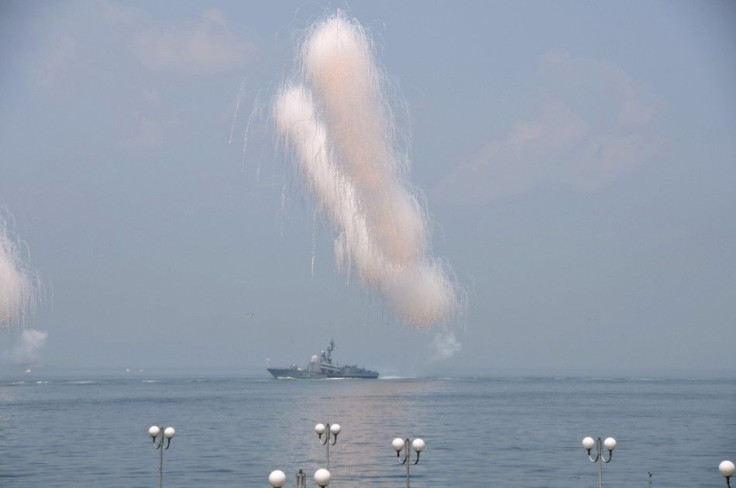US Navy Asks For More Funds to Buy F/A-18 Fighter Jets: To Deploy Bulk of Fleet In Pacific To Checkmate China’s South China Sea Activities

Faced with new challenges, the U.S. Navy has forwarded a wish list of more funds for arms to the U.S. Congress to finance its plans to procure new fighter jets, F/A-18 Super Hornets and EA-18G Growlers. According to Chief of Naval Operations, Jonathan Greenert, the Navy has a "a whole host" of reasons in pressing for more funds as it may encounter deficit in aircraft carriers in the next decade, as the older models of F/A-18 are set to retire.
For Navy, the most pressing compulsion is its plans to focus on the Pacific, where it wants to shift 60 percent of the fleet by 2020, as China is expanding its naval prowess in the region. The U.S. Navy is currently working with Boeing to refurbish its fighter jets in restoring the older aircraft to increase the availability rate which had decreased by 50 percent. Fortune reports that even as F-35 Joint Strike Fighter program is mired in criticism over cost overruns and missed milestones, the U.S. Navy is still swearing by the good old standby -- the Boeing-built F/A-18 Super Hornet.
The Navy’s wish list was presented to the lawmakers’ in March end and it makes a specific demand for 12 Boeing-built F/A-18 fighter jets and 8 Lockheed Martin F-35Cs, to be made available on a priority. In terms of costs, each purchase would be worth $1 billion, if at all the Congress decides to fund them.
China Threat
One of the main concerns of the U.S, Navy is China’s "unprecedented land reclamation," in south China seas and efforts at "creating a great wall of sand" over four square kilometers in the disputed area of the sea. In Australia, on Monday, the U.S. Pacific Fleet Commander Admiral Harry Harris Jr. said China has been “pumping sand on to live coral reefs -- some of them submerged -- and paving over them with concrete. China has now created over 4 square kilometers (1.5 square miles) of artificial landmass." He said what is of concern is the unprecedented land reclamation currently being conducted by China," Harris added, according to Russian news agency RT.
China claims a vast majority of the south China sea and has territorial disputes with the Philippines, Vietnam, Taiwan, Brunei, and Malaysia on it. Already Vietnam and the Philippines have filed a diplomatic protest with Beijing. The U.S. military and regional players harbours the suspicion that these islands could be used for military facilities to realise China’s territorial ambitions. "How China proceeds will be a key indicator of whether the region is heading toward confrontation or cooperation," Harris said.
U.S. Fleet in Pacific
China roots its territorial claims to a historical basis and has advised the U.S. not to meddle with these disputes. However, the U.S. is also bolstering its military presence in the region. Commander Harris said the United States is currently preparing to shift 60 percent of its fleet to the Pacific by 2020.
In the region, Australia also shares similar concerns about the South China sea situation. In 2014, it agreed with Japan to increase military cooperation and undertake exercises as a hedge against China’s growing military potential. To prevent any immediate flare up, the U.S. has advised all claimants in South China sea to comply with the 2002 China-ASEAN Declaration of Conduct, in which the parties are committed to “exercise self-restraint in the conduct of activities that would complicate or escalate disputes and affect peace and stability.”
Iranian Provocation
Meanwhile, the U.S. Navy faced a new threat in Persian Gulf. An Iranian military observation aircraft reportedly tried to aggressively fly within 50 yards of an armed U.S. Navy helicopter over the Persian Gulf in March. The incident was kept under waraps, but was reported in media. It sparked concern in U.S military that top Iranian commanders are not in full control of local forces, reports CNN.
The incident has worried U.S. military officials as a matter of unsafe maneuver, that could have led to a serious incident. It surprised U.S. commanders because Iranian forces had recently conducted exercises in the region in a professional manner, One U.S. military official told CNN that "We think this might have been locally ordered." The incident took place when Navy MH-60R armed helicopter was flying from the deck of the USS Carl Vinson on its routine patrol in international airspace. Suddenly, an unarmed Iranian observation Y-12 aircraft approached and made passes at the helicopter, within 50 yards and then it moved off. The Navy helicopter had radio contact with the ship during the encounter, but the two aircraft had no contacts and no shots were fired. Though the Navy crew took photos of the incident, the military has not released it.
(For feedback/comments, contact the writer at kalyanaussie@gmail.com)





















